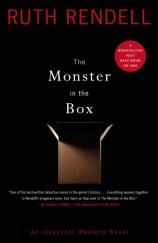The Monster in the Box: An Inspector Wexford Novel
Review
The Monster in the Box: An Inspector Wexford Novel
A detective is the GPS of the mystery world, giving direction
and reassurance to readers when scary tales veer into dangerous
territory. Because there is a character we know to be a reliable
narrator/guide (neither nuts nor homicidal), a frightening sequence
of events is framed and contained enough to be tolerable.
Inspector Reginald Wexford has been a reader favorite since his
appearance in Ruth Rendell’s 1964 novel (her first), FROM
DOON WITH DEATH. This civilized, thoughtful and endearingly
ordinary policeman is not some glamorous, poetry-writing,
cape-wearing aristocratic presence (though he does read a lot and
loves classical music); he is one of those stealth heroes who turns
out to be much sharper than he seems.
For Rendell in particular --- known for her fascination with the
dark, even psychopathic side of human behavior --- a detective is a
useful counterweight. (Her most disquieting novels, in fact, do not
feature Wexford or any other crime-solving authority figure.) But
don’t assume that Wexford is Miss Marple in disguise. With or
without him, Rendell’s mysteries are not cozy fare. Over the
last 40-odd years, she has challenged the conventions of the genre
and invented a chilling brand of suspense that subverts our peace
of mind and our naïve assumptions about good and evil.
We’d rather not see the warped psyches she shows us, yet her
stories have such macabre fascination that we can’t look
away.
Rendell’s books have been called “whydunits”
rather than “whodunits” because of her preoccupation
with motive, and THE MONSTER IN THE BOX runs true to form. Usually,
mysteries start with a crime, a body, something concrete. This
novel starts with a suspect: A sinister fellow named Targo, whom
Wexford encountered years ago in connection with a homicide,
suddenly resurfaces in Kingsmarkham, the fictional Sussex village
where this series is set. The inspector is sure that Targo is
guilty of more than one murder, but there is no proof, no apparent
rhyme or reason --- only the veteran copper’s stubborn
belief. Rendell prolongs this state of uncertainty so long that the
reader begins to wonder if Wexford is imagining things.
Wexford was a young policeman when his path first crossed
Targo’s. As he recalls those years in a series of flashbacks
--- which include some rather touching romantic follies --- he
dwells plaintively on the way age has limited his pleasures and
change has altered Kingsmarkham. Where there used to be cottages
with outdoor privies and meadows alive with birdsong, there are now
parking lots, malls and a modernized police station. These moments
of reminiscence, while not strictly relevant to the mystery itself,
give the novel a certain poignancy and social resonance.
Since that long-ago meeting, Targo has stalked and haunted
Wexford --- so much so that the inspector resorts to a technique
introduced to him by his daughter Sylvia (in real life, Rendell got
the idea from her son): “‘If you’ve a problem
weighing on your mind, Dad,’” she says,
“‘You have to visualise a box…. You open it and
put your worry inside…. Close the box with the worry inside
and put it away somewhere, inside a drawer, say.’”
Hence the title THE MONSTER IN THE BOX, which also suggests a
menacing figure who pops up out of nowhere to stun and alarm
us.
Linked to the Targo story, but rather tenuously, is a racially
charged subplot involving the growing immigrant population of
Kingsmarkham (another change in the local landscape). Is Tamima, a
young Pakistani woman, being forced by her family into an arranged
marriage? That’s what the girl’s teacher and a gung-ho
female police officer (whose political correctness verges on the
satirical) believe. The author’s intention is clearly to
reveal the unconscious biases of earnest, well-intentioned liberals
--- “benevolent racists,” in the words of
Tamima’s aunt, Faduma Qasi. Mrs. Qasi continues: “You
expected to see a downtrodden old woman in a burka, didn’t
you? You think all Moslem women are like that and your mission in
life is to set them free and emancipate them. But I don’t
quite fit the picture, do I?”
A powerful speech, and undoubtedly justified, but it seems
dragged in to make a point. The novel is best when it sticks to
Wexford, whom Rendell treats with extraordinary affection and
depth, as if she is saying goodbye to a beloved character.
Actually, last summer there was talk that she was about to kill the
inspector off. Although her longtime editor swiftly denied the
rumor, the blurring of past and present does give the book an
elegiac quality.
In the end, I think your attitude toward the novel will depend
largely on your relationship to Wexford. If you’re old
friends, you’ll be fascinated and intrigued by this glimpse
of his roots. If it’s your first meeting, you’re better
off going back to Rendell’s earlier Wexford novels. Get to
know him. If you grow fond of him, you’ll naturally become
curious about his past. And then the time will be right for THE
MONSTER IN THE BOX.
Reviewed by Kathy Weissman on January 7, 2011





